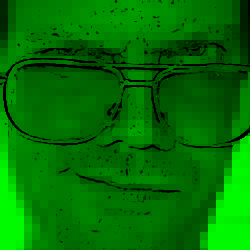Even though it's noise, I tried to figure out how you could turn it into a puzzle. You could give players a picture of part of the floor, a picture that didn't reveal which part of the floor. Gray out a 2x3 rectangle from that. So players need to search the floor to find the pictured area. Then they figure out the true contents of the 2x3 rectangle. That gives them a Braille letter. Repeat a few times to give them more letters. Would it be fun? I don't know; it was a big floor. I tried searching it for any 4x4 same-color areas. I found a bunch of 3x3 areas, as you'd expect, but no 4x4, also unsurprisingly*. (This photo from a 2008 version of 50/50 floor doesn't seem "clumpy" enough to be truly random. I wonder if Auerbach cheated on the shuffling for that one or the photographer just chose an especially non-clumpy area? Anyhow.) But I don't really know that there are no 4x4 areas; I only know that I didn't find any. It was difficult to maintain concentration. It was difficult to tell whether I was maintaining concentration.
Above the floor hummed Rafael Lozano-Hemmer's Homographies, a number of fluorescent tubes set up to rotate. They didn't rotate all the time; occasionally they paused. As every true puzzler knows, that art installation wants to be semaphore.
*The floor is about 100*few100 tiles.
